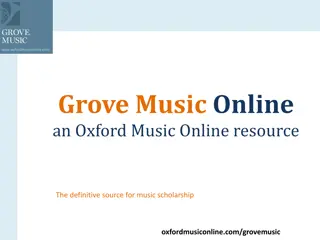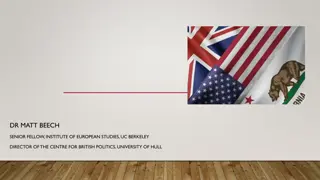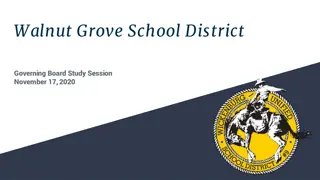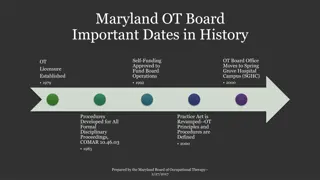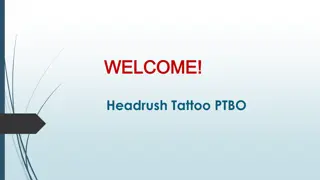
School Culture and Leverage Points for Effective Leadership
Explore the concept of school culture and discover key leverage points for leaders seeking to bring about positive change within their organizations. Gain insights into the origins of culture, the distinction between culture and climate, and what school culture is not. Delve into the influence of shared beliefs, values, and behavior in shaping school culture.
Download Presentation

Please find below an Image/Link to download the presentation.
The content on the website is provided AS IS for your information and personal use only. It may not be sold, licensed, or shared on other websites without obtaining consent from the author. If you encounter any issues during the download, it is possible that the publisher has removed the file from their server.
You are allowed to download the files provided on this website for personal or commercial use, subject to the condition that they are used lawfully. All files are the property of their respective owners.
The content on the website is provided AS IS for your information and personal use only. It may not be sold, licensed, or shared on other websites without obtaining consent from the author.
E N D
Presentation Transcript
A Saturday Morning Leadership Chat Steve Gruenert Indiana State University Beech Grove, Indianapolis November 2, 2019 SCHOOL CULTURE AND LEVERAGE POINTS As more leaders seek to change the culture of their organizations, we find many who are unable to do so. It is not for a lack of effort so much as it is pushing too hard in all the wrong places. They need to better understand the concept of school culture and where the leverage points are.
Apologies Apologies & & Warnings Warnings I love this stuff, I may come across with a level of passion that may feel like a guarantee. After 20 years of doing research on school culture I feel the need to protect it. I can get too conceptual, it is a fuzzy topic. I haven t gotten it all figured out yet.
In ineffective settings In ineffective settings there are irrelevant there are irrelevant variables in play. variables in play. The wrong things matter.
What do we mean when we use the term school culture? Every person is a conglomerate of the beliefs and values of the groups he or she has grown up in. When those beliefs and values are basically the same for a bunch of people, the term culture becomes a convenient word to capture those shared beliefs and values. They are then acted out in similar behavior such as using the same language, having shared norms, etc. Edgar Schein, 1-31-19
Where cultures come from When people hang around each other long When people hang around each other long enough, a social hierarchy develops according to enough, a social hierarchy develops according to whoever is able to meet the group s needs best. whoever is able to meet the group s needs best.
What is not school culture? What is not school culture? School climate School diversity Cultural competence Cultural literacy Pop Culture Counter culture World culture Community culture Culture club Cult of personality Cults in general The occult protecting culture
They are not the same thing Climate . . . (mood) Culture . . . (religion) is the group's attitude. is the group's personality. protecting culture is the fever. is the immune system. differs from Monday to Friday. gives Mondays permission to be miserable. is easy to change. takes years to evolve. . . . is in your head. . . . is in your head.
Culture strength strong weak strong
A culture of ______________ Too many are highjacking the concept and using it as a buzzword to market their latest idea. Most mean well, and are improving schools, they just grabbed the wrong word. protecting culture
Creating a new culture OF protecting culture Non-violence Kindness Critical thinking Honesty Gratitude Trust Growth mindsets Friendliness Happiness Humor Intelligence Good will Optimism Hope Positivity Altruism Caring Generosity Urgency Life-long learning Empathy Morality Self-discipline Pride Efficacy Humility Respect Resilience Integrity Creativity Responsibility Courage Just say this is very important to us.
For example, to announce a new For example, to announce a new culture of caring culture of caring implies implies Caring is now the most important trait we will cherish, exhibit, and advocate for. Caring will be what we do above everything else. Because only one thing can be most important, this is it. We have not been a caring organization, to this degree, in the past. But now, we know how to do it. And, people without this level of caring will be ostracized. protecting culture
protecting culture If you say you have a culture of ____________, you should not have to tell me. It should be obvious.
Natural Leverage Points Natural Leverage Points Times when the culture is when the culture is expecting Times expecting a change to occur a change to occur: : New leadership New leadership New faculty New faculty Start of school year/calendar shifts Start of school year/calendar shifts Holidays/ceremonies Holidays/ceremonies First First- -time events time events Crises Crises
The Elements of Organizational Culture: Leverage Points VISION (what do people look forward to) MISSION (why are we here) RITUALS/ROUTINES (organizational habits) LANGUAGE (local jargon, humor) CEREMONIES (glorified rituals) SYMBOLS (tangible stuff) VALUES & BELIEFS (what s really important and why) HEROES (who are we proud of) NORMS (unwritten rules) CLIMATE(the mood we are usually in) STORIES(myths passed on to rookies) TOOLS (what we use to get work done)
The Elements of Organizational Culture Becoming a Culture - vulnerable 1 YEARS 2 3 4 5 NORMS MISSION Each element loads at a different, local pace. SYMBOLS HEROES STORIES LANGUAGE VISION RITUALS/ROUTINES CEREMONIES VALUES & BELIEFS CLIMATE
The Elements of Organizational Culture Becoming a Culture 2 YEARS 1 3 4 5 NORMS MISSION SYMBOLS HEROES STORIES LANGUAGE VISION RITUALS/ROUTINES CEREMONIES VALUES & BELIEFS CLIMATE
The Elements of Organizational Culture Becoming a Culture 3 YEARS 1 2 4 5 NORMS MISSION SYMBOLS HEROES STORIES LANGUAGE VISION RITUALS/ROUTINES CEREMONIES VALUES & BELIEFS CLIMATE
The Elements of Organizational Culture Becoming a Culture 4 YEARS 1 2 3 5 NORMS MISSION SYMBOLS HEROES STORIES LANGUAGE VISION RITUALS/ROUTINES CEREMONIES VALUES & BELIEFS CLIMATE
The Elements of Organizational Culture Becoming a Culture 5 YEARS 4 1 2 3 NORMS MISSION SYMBOLS Once all have become filled, 3-5 years, the culture is in place. HEROES STORIES LANGUAGE VISION RITUALS/ROUTINES CEREMONIES VALUES & BELIEFS CLIMATE
The Elements of Organizational Culture Full strength difficult to change YEARS 1 2 3 4 5 NORMS MISSION SYMBOLS Once all have become filled, 3-5 years, the culture is in place. HEROES STORIES LANGUAGE VISION RITUALS/ROUTINES CEREMONIES VALUES & BELIEFS CLIMATE 1 second = 6 months
Using the lens of school culture to look at data Using the lens of school culture to look at data to identify potential leverage points. to identify potential leverage points. Collecting/analyzing data is 5% of the exercise. 95% is knowing what to do next.
With any form of data collection Know the easy wins, the Know the easy wins, the successes, and what to avoid. successes, and what to avoid. Don t rush in and try to tackle the ugliest problems first.
For example The School Culture Survey 35 items that simply inventory the frequency of behaviors that occur in a school. Not measuring culture. These items are a sampling of footprints of a collaborative school culture. Not measuring culture. Standard Deviations suggest culture strength. Factor analyzed, which tell us which items are connected.
N= 31 Example: Analyzing School Culture Survey Data You have the data, now what do you do?
Analyzing (ANY) School Culture Survey Data Which items to mess with, which items to leave alone, which gain attention Low SD/Low Mean = sacred cow High SD/High Mean = easy win Low SD/High Mean = success story High SD/Low Mean = not so easy win Low SD/ Low Mean XXXXXXXXXX XX XXXXX X XXX XXX XX X X XX X 1 2 3 4 5 Low SD/ High Mean XX X X X XXXXXX XX XXXXXXXXXX XX 1 2 3 4 5 High SD/ High Mean XX X X X X XX XX XX XX X X XX XXX XX X X 1 2 3 4 5 High SD/ Low Mean XX X X XX XX XXX XX XX X X XXX XX X XX X X X 1 2 3 4 5
Analyzing (ANY) Survey Data Been that way a long time: they might like it there Low SD/ Low Mean XXXXXXXXXX XX XXXXX X XXX XXX XX X X XX X 1 2 3 4 5 Low SD/ High Mean XX X X X XXXXXX XX XXXXXXXXXX XX 1 2 3 4 5 High SD/ High Mean XX X X X X XX XX XX XX X X XX XXX XX X X 1 2 3 4 5 High SD/ Low Mean XX X X XX XX XXX XX XX X X XXX XX X XX X X X 1 2 3 4 5
Analyzing (ANY) Survey Data Most everyone agrees, this is why we are a good school Low SD/ Low Mean XXXXXXXXXX XX XXXXX X XXX XXX XX X X XX X 1 2 3 4 5 Low SD/ High Mean XX X X X XXXXXX XX XXXXXXXXXX XX 1 2 3 4 5 High SD/ High Mean XX X X X X XX XX XX XX X X XX XXX XX X X 1 2 3 4 5 High SD/ Low Mean XX X X XX XX XXX XX XX X X XXX XX X XX X X X 1 2 3 4 5
Analyzing (ANY) Survey Data These people see it, they need to tell others Low SD/ Low Mean XXXXXXXXXX XX XXXXX X XXX XXX XX X X XX X 1 2 3 4 5 Low SD/ High Mean XX X X X XXXXXX XX XXXXXXXXXX XX 1 2 3 4 5 High SD/ High Mean XX X X X X XX XX XX XX X X XX XXX XX X X 1 2 3 4 5 High SD/ Low Mean XX X X XX XX XXX XX XX X X XXX XX X XX X X X 1 2 3 4 5
N= 31 Analyzing School Culture Survey Data 9 2
Any good survey will be factor analyzed Factors in the School Culture Survey no item stands alone
Easy Wins 2. Leaders value teachers ideas. Mean = 3.8, SD = 1.2 9. Teachers regularly seek ideas from seminars, colleagues, and conferences. Mean = 4.1, SD = 0.9
Stories that change #2 Current stories Who is telling them Who should be telling the new stories Stories that change #9 Current stories Who is telling them Who should be telling the new stories
Analyzing School Culture Survey Data, 35 Items 1.2 2 Your Highest SD Easy wins 2, 9 22 1.0 32 0.9 11 23 9 Successes 24, 25, 30 20 12 16 14 28 0.7 21 29 10 26 15 8 17 7 4 34 33 19 31 6 5 1 3 35 Avoid 15 27 0.5 30 25 18 Your Lowest SD 24 0.3 13 2.5 2.9 3.3 3.7 4.1 4.5 Your Your Highest Mean Lowest Mean
Successes (high mean, low SD) will get their attention. Topics for conversations Easy wins (high mean, high SD) buys confidence, weakens culture. Topics for building strategies Avoid items (low mean, low SD) that give toxic teachers ammunition. Topics not for conversations or strategies
With any form of data collection Know the easy wins, the Know the easy wins, the successes, and what to avoid. successes, and what to avoid. Don t rush in and try to tackle the ugliest problems first.
Any Survey Data, 40 Items 1.2 Highest SD 2 28 22 7 19 3 14 16 17 6 35 8 5 13 12 20 38 27 34 21 26 10 1.0 Easy wins 5, 10, 28, 30 31 29 30 32 24 25 39 11 1 23 33 15 40 0.9 18 4 Successes 1, 4, 18, 36 9 0.7 36 37 Avoid 9, 35, 37 0.5 Lowest SD 0.3 2.1 2.5 2.9 3.3 3.7 4.1 4.5 Highest Mean Lowest Mean
Any Survey Data, 24 Items 1.2 Highest SD 4 6 9 11 20 27 1.0 Easy wins 9, 21 15 8 2 18 7 1617 5 21 13 12 0.9 22 Successes 1, 19, 24, 25, 3 10 0.7 14 Avoid 14, 22, 35 1 19 0.5 Lowest SD 0.3 2.1 2.5 2.9 3.3 3.7 4.1 4.5 Highest Mean Lowest Mean
What I hope today made clear: What I hope today made clear: Identifying which items to work on, which to avoid, Identifying which items to work on, which to avoid, and which will support the effort and which will support the effort revealing the values and beliefs can help leverage the culture. values and beliefs can help leverage the culture. revealing the Identifying who should be involved, building new Identifying who should be involved, building new stories, and let the new culture drift in without stories, and let the new culture drift in without making a lot of noise. making a lot of noise.
steve.gruenert@indstate.edu steve.gruenert@indstate.edu Thank You!





